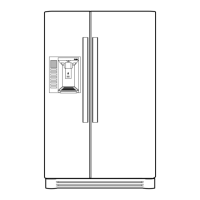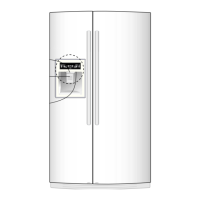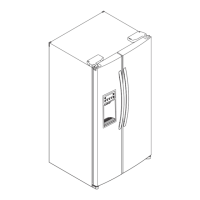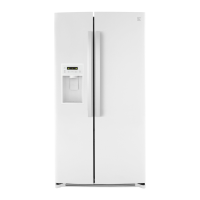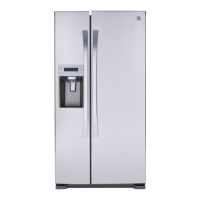Do you have a question about the Kenmore 795.58826.900 and is the answer not in the manual?
Details electrical ratings, temperature control, and energy consumption.
Describes performance under no-load conditions at different ambient temperatures.
Lists compressor capacity, pressure, refrigerant type, and compressor performance.
Specifies minimum clearance requirements for proper air circulation and cooling.
Instructions on how to adjust refrigerator doors for proper leveling.
Details the procedure for testing the icemaker's operation and water supply.
Overview of the refrigerator's main control panel and its buttons.
Explains initial settings and behavior after power restoration.
Instructions for switching display between Fahrenheit and Celsius.
Details on locking the control panel, dispenser, and buttons.
Explains the indicator light for water filter replacement.
How to activate and use the quick freezing function.
How to select water, crushed ice, or ice cubes from the dispenser.
Describes fan speeds and control logic for the freezer compartment.
Explains the cooling fan's operation in conjunction with the compressor.
Explains the purpose, operation, and timing of the Ultra Ice function.
Details the automatic shut-off feature for the refrigerator lamp.
Describes the buzzer alarm for open doors and its timing.
Explains when and how the defrosting cycle starts and stops.
Introduces the automatic diagnosis system for identifying defects.
Identifies the buttons used to initiate and control test modes.
Explains how to activate, use, and deactivate the demonstration mode.
Explains the switched-mode power supply and its components.
Details the circuit for operating loads and dispensers.
Explains the circuits for temperature sensors.
Describes the circuit for test switches and damper motor reed switches.
Explains the circuit configuration for model separation based on factory settings.
Details the circuit that controls the stepping motor's operation.
Outlines the step-by-step operation of the icemaker.
Explains how the icemaker initializes and checks its position.
Describes the process of freezing water into ice.
Details the process of removing ice from the tray.
Explains the water filling process and the park position.
Details the procedure for forced operation testing of the icemaker.
Explains how to identify and diagnose icemaker errors.
Provides common issues, causes, and checking methods for troubleshooting.
Details causes and checks for high temperatures in the refrigerator compartment.
Details causes and checks for automatic operation failures due to faulty contacts.
Explains causes and checks for condensation and ice buildup.
Details causes and checks for various sounds produced by the refrigerator.
Lists causes and checks for faulty lamps in both compartments.
Addresses causes and checks for internal voltage issues and short circuits.
Details issues related to no power and blown fuses.
Covers problems with compressor operation, including freezing.
Explains causes and checks for high temperatures in the freezer compartment.
Details causes and checks for refrigerant leaks and shortages affecting cooling.
Covers vibration from shelves, pipes, stoppers, and other structural parts.
Explains irregular click sounds from heat expansion and contraction.
Covers popping sounds from refrigerant and water flowing sounds.
Explains whistle sounds caused by pressure changes when the door closes.
Details issues with defrost lead wires, relays, and sensors.
Explains malfunctions of the buzzer and door opening alarm.
Covers non-responsive display buttons due to wiring or structural interference.
Details display button issues and buzzer malfunctions.
Covers issues with water/ice dispensing, including wiring and relays.
Provides a general overview of the key steps in sealed system repair.
Covers refrigerant removal, vacuuming, charging, and leak checks.
Details parts replacement, welding, compressor preparation, and installation.
Emphasizes the need for special tools and parts for R134a systems.
Details the correct sequence for recovering refrigerant to prevent oil loss.
Advises replacing the drier only with R134a compatible parts during pipe repair.
Explains the use of pressurized nitrogen to prevent pipe oxidation during welding.
Steps for removing residual refrigerant, including key points.
Details nitrogen blowing for welding, especially for drier and compressor replacement.
Explains the process of replacing the drier and inserting the capillary tube.
Outlines the pipe connections and vacuum sequence for degassing.
Details the charging sequence, including weight calculation and temperature considerations.
Describes how to test for leaks using an electronic leakage tester.
Instructions for arranging pipes correctly during component replacement.
Explains sources of hiss, click, clunk, and vibration sounds.
Details sounds related to refrigerant flow and MICOM switch operations.
Explains sounds produced by the icemaker during its cycle.
Describes sounds associated with water supply to the dispenser.
Explains sounds from ice crushing and dispensing operations.
Covers weak, strong, and frozen vegetables issues, and temperature settings.
Addresses chilled drawer, water temp, and ice cream storage temperature concerns.
Specific issue of food freezing near the cooling air outlet and blocking circulation.
Explains food odors and cleaning procedures for the refrigerator.
Details causes of frost buildup, including door openings and temperature settings.
Explains frost formation related to ice tray water and fan operation.
Covers hot case, door holes, and electric bills related to appliance design.
Addresses condensation, power connection timing, and door operation.
Step-by-step guide for removing and reassembling refrigerator doors.
Instructions for removing the door handle using an Allen wrench.
Details the process for disassembling and removing the fan shroud grille.
Details electrical ratings, temperature control, and energy consumption.
Describes performance under no-load conditions at different ambient temperatures.
Lists compressor capacity, pressure, refrigerant type, and compressor performance.
Specifies minimum clearance requirements for proper air circulation and cooling.
Instructions on how to adjust refrigerator doors for proper leveling.
Details the procedure for testing the icemaker's operation and water supply.
Overview of the refrigerator's main control panel and its buttons.
Explains initial settings and behavior after power restoration.
Instructions for switching display between Fahrenheit and Celsius.
Details on locking the control panel, dispenser, and buttons.
Explains the indicator light for water filter replacement.
How to activate and use the quick freezing function.
How to select water, crushed ice, or ice cubes from the dispenser.
Describes fan speeds and control logic for the freezer compartment.
Explains the cooling fan's operation in conjunction with the compressor.
Explains the purpose, operation, and timing of the Ultra Ice function.
Details the automatic shut-off feature for the refrigerator lamp.
Describes the buzzer alarm for open doors and its timing.
Explains when and how the defrosting cycle starts and stops.
Introduces the automatic diagnosis system for identifying defects.
Identifies the buttons used to initiate and control test modes.
Explains how to activate, use, and deactivate the demonstration mode.
Explains the switched-mode power supply and its components.
Details the circuit for operating loads and dispensers.
Explains the circuits for temperature sensors.
Describes the circuit for test switches and damper motor reed switches.
Explains the circuit configuration for model separation based on factory settings.
Details the circuit that controls the stepping motor's operation.
Outlines the step-by-step operation of the icemaker.
Explains how the icemaker initializes and checks its position.
Describes the process of freezing water into ice.
Details the process of removing ice from the tray.
Explains the water filling process and the park position.
Details the procedure for forced operation testing of the icemaker.
Explains how to identify and diagnose icemaker errors.
Provides common issues, causes, and checking methods for troubleshooting.
Details causes and checks for high temperatures in the refrigerator compartment.
Details causes and checks for automatic operation failures due to faulty contacts.
Explains causes and checks for condensation and ice buildup.
Details causes and checks for various sounds produced by the refrigerator.
Lists causes and checks for faulty lamps in both compartments.
Addresses causes and checks for internal voltage issues and short circuits.
Details issues related to no power and blown fuses.
Covers problems with compressor operation, including freezing.
Explains causes and checks for high temperatures in the freezer compartment.
Details causes and checks for refrigerant leaks and shortages affecting cooling.
Covers vibration from shelves, pipes, stoppers, and other structural parts.
Explains irregular click sounds from heat expansion and contraction.
Covers popping sounds from refrigerant and water flowing sounds.
Explains whistle sounds caused by pressure changes when the door closes.
Details issues with defrost lead wires, relays, and sensors.
Explains malfunctions of the buzzer and door opening alarm.
Covers non-responsive display buttons due to wiring or structural interference.
Details display button issues and buzzer malfunctions.
Covers issues with water/ice dispensing, including wiring and relays.
Provides a general overview of the key steps in sealed system repair.
Covers refrigerant removal, vacuuming, charging, and leak checks.
Details parts replacement, welding, compressor preparation, and installation.
Emphasizes the need for special tools and parts for R134a systems.
Details the correct sequence for recovering refrigerant to prevent oil loss.
Advises replacing the drier only with R134a compatible parts during pipe repair.
Explains the use of pressurized nitrogen to prevent pipe oxidation during welding.
Steps for removing residual refrigerant, including key points.
Details nitrogen blowing for welding, especially for drier and compressor replacement.
Explains the process of replacing the drier and inserting the capillary tube.
Outlines the pipe connections and vacuum sequence for degassing.
Details the charging sequence, including weight calculation and temperature considerations.
Describes how to test for leaks using an electronic leakage tester.
Instructions for arranging pipes correctly during component replacement.
Explains sources of hiss, click, clunk, and vibration sounds.
Details sounds related to refrigerant flow and MICOM switch operations.
Explains sounds produced by the icemaker during its cycle.
Describes sounds associated with water supply to the dispenser.
Explains sounds from ice crushing and dispensing operations.
Covers weak, strong, and frozen vegetables issues, and temperature settings.
Addresses chilled drawer, water temp, and ice cream storage temperature concerns.
Specific issue of food freezing near the cooling air outlet and blocking circulation.
Explains food odors and cleaning procedures for the refrigerator.
Details causes of frost buildup, including door openings and temperature settings.
Explains frost formation related to ice tray water and fan operation.
Covers hot case, door holes, and electric bills related to appliance design.
Addresses condensation, power connection timing, and door operation.
Step-by-step guide for removing and reassembling refrigerator doors.
Instructions for removing the door handle using an Allen wrench.
Details the process for disassembling and removing the fan shroud grille.
| Brand | Kenmore |
|---|---|
| Model Number | 795.58826.900 |
| Category | Refrigerator |
| Type | French Door |
| Ice Maker | Yes |
| Water Dispenser | Yes |
| Finish / Color | Stainless Steel |
| Energy Star Certified | Yes |
| Height | 69.875 inches |
| Width | 35.75 inches |
